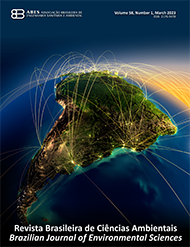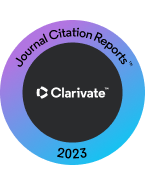Bioconversion of orange pomace using Hermetia illucens larvae: development and nutritional composition of the larvae
DOI:
https://doi.org/10.5327/Z2176-94781974Palavras-chave:
resíduo agroindustrial; biomassa larval; proteína alternativa; BSFL; alimentação animalResumo
A laranja, uma fruta popular, gera grandes quantidades de resíduos, com metade descartada como bagaço após a extração do suco, contribuindo para os 110-120 milhões de toneladas de resíduos cítricos anualmente, e criando desafios ambientais, especialmente em relação à poluição do solo e da água. Sendo assim, este estudo tem por objetivo avaliar a bioconversão utilizando larvas de Hermetia illucens (BSFL) alimentadas com bagaço de laranja, analisando a eficácia do processo e a qualidade nutricional das larvas resultantes. Testes preliminares demonstraram que o bagaço de laranja puro não oferece o aporte nutricional necessário para o desenvolvimento da BSFL. Com isso, as dietas foram complementadas com resíduo farináceo e definidas com base em diferentes concentrações do bagaço de laranja: LA25 (25% de bagaço, 75% de resíduo farináceo), LA50 (50% de bagaço, 50% de resíduo farináceo), LA75 (75% de bagaço, 25% de resíduo farináceo) e LA0 (100% de resíduo farináceo). Foram avaliados o desempenho larval, o desenvolvimento em bioconversão e a qualidade nutricional da BSFL. Os resultados mostraram que a BSFL pode efetivamente converter bagaço de laranja, aproveitar seus nutrientes e, portanto, reduzir seu potencial poluente. De forma geral, utilizando somente o bagaço de laranja puro, não houve crescimento larval, embora níveis crescentes de inclusão do resíduo farináceo tenha alterado parâmetros de desenvolvimento e de bioconversão, bem como a qualidade nutricional da BSFL (p≤0,05). Assim, observou-se que a inclusão de 25% do resíduo farináceo (LA75) melhorou o desempenho global da BSFL (p≤0,05), propiciando tambéma valoração deste resíduo em relação a todos os parâmetros avaliados.
Downloads
Referências
Adámková, A.; Mlček, J.; Adámek, M.; Borkovcová, M.; Bednářová, M.; Hlobilová, V.; Juríková, T., 2020. Tenebrio molitor (Coleoptera: Tenebrionidae) - Optimization of rearing conditions to obtain desired nutritional values. Journal of Insect Science, v. 20, (5), 24. https://doi.org/10.1093/jisesa/ieaa100
Association of Official Analytical Chemists (AOAC), 2016. Official Methods of Analysis of AOAC International. 20. ed. AOAC International, Rockville, Maryland.
Bosch, G.; Oonincx, D.G.A.B.; Jordan, H.R.; Zhang, J.; Van Loon, J.J.A.; Van Huis, A.; Tomberlin, J.K., 2020. Standardisation of quantitative resource conversion studies with black soldier fly larvae. Journal of Insects as Food and Feed, v. 6, (2), 95-109. https://doi.org/10.3920/JIFF2019.0004
Cammack, J.A.; Tomberlin, J.K., 2017. The impact of diet protein and carbohydrate on select life-history traits of the black soldier fly Hermetia illucens (L.) (Diptera: Stratiomyidae). Insects, v. 8, (2), 56. https://doi.org/10.3390/insects8020056
Chiam, Z.; Lee, J.T.E.; Tan, J.K.N.; Song, S.; Arora, S.; Tong, Y.W.; Tan, H T.W., 2021. Evaluating the potential of okara-derived black soldier fly larval frass as a soil amendment. Journal of Environmental Management, v. 286, 112163. https://doi.org/10.1016/j.jenvman.2021.112163
Cypriano, D.Z.; Da Silva, L.L.; Mariño, M.A.; Tasic, L., 2017. Orange biomass by-products. Revista Virtual de Química, v. 9, (1), 176-191. https://doi.org/10.21577/1984-6835.20170014
da Cruz, R.M.S.; da Silva, C.; da Silva, E.A.; Hegel, P.; Barão, C.E.; Cardozo-Filho, L., 2022. Composition and oxidative stability of oils extracted from Zophobas morio and Tenebrio molitor using pressurized n-propane. The Journal of Supercritical Fluids, v. 181, 105504. https://doi.org/10.1016/j.supflu.2021.105504
Dortmans, B.; Diener, S.; Bart, V.; Zurbrügg, C., 2017. Black soldier fly biowaste processing: a step-by-step guide. Eawag (Accessed September 24, 2023) at:. https://www.dora.lib4ri.ch/eawag /islandora/object/ eawag:15615
dos Santos, L.A.; Santos, A.F.F.; Valença, R.B.; Jucá, J.F.T.; Oliveira, C.R.M., 2018. Produção de biogás a partir de bagaço de laranja. Revista Geama, v. 4, (3), 22-27.
Ebeneezar, S.; Tejpal, C.S.; Jeena, N.S.; Summaya, R.; Chandrasekar, S.; Sayooj, P.; Vijayagopal, P., 2021. Nutritional evaluation, bioconversion performance and phylogenetic assessment of black soldier fly (Hermetia illucens, Linn. 1758) larvae valorized from food waste. Environmental Technology & Innovation, v. 23, 101783. https://doi.org/10.1016/j.eti.2021.101783
Hahn, T.; Roth, A.; Febel, E.; Fijalkowska, M.; Schmitt, E.; Arsiwalla, T.; Zibek, S., 2018. New methods for high‐accuracy insect chitin measurement. Journal of the Science of Food and Agriculture, v. 98, (13), 5069-5073. https://doi.org/10.1002/jsfa.9044
Jenkins, S.N.; Middleton, J.A.; Huang, Z.; Mickan, B.S.; Andersen, M.O.; Wheat, L.; Abbott, L.K., 2023. Combining frass and fatty acid co-products derived from Black soldier fly larvae farming shows potential as a slow release fertilizer. Science of the Total Environment, v. 899, 165371. https://doi.org/10.1016/j.scitotenv.2023.165371
Jeon, H.; Park, S.; Choi, J.; Jeong, G.; Lee, S.B.; Choi, Y.; Lee, S.J., 2011. The intestinal bacterial community in the food waste-reducing larvae of Hermetia illucens. Current Microbiology, v. 62, 1390-1399. https://doi.org/10.1007/s00284-011-9874-8
Komilus, C.F.; Mufit, N.M.M., 2021. Dried acetes as growth promoter for guppy (Poecilia reticulata) nutrition. IOP Conference Series: Earth and Environmental Science, v. 919, (1), 012049. https://doi.org/10.1088/1755-1315/919/1/012049
Lalander, C.; Diener, S.; Zurbrügg, C.; Vinnerås, B., 2019. Effects of feedstock on larval development and process efficiency in waste treatment with black soldier fly (Hermetia illucens). Journal of Cleaner Production, v. 208, 211-219. https://doi.org/10.1016/j.jclepro.2018.10.017
Lee, C.M.; Lee, Y.S.; Seo, S.H.; Yoon, S.H.; Kim, S.J.; Hahn, B.S.; Koo, B.S., 2014. Screening and characterization of a novel cellulase gene from the gut microflora of Hermetia illucens using metagenomic library. Journal of Microbiology and Biotechnology, v. 24, (9), 1196-1206. https://doi.org/10.4014/jmb.1405.05001
Lu, S.; Taethaisong, N.; Meethip, W.; Surakhunthod, J.; Sinpru, B.; Sroichak, T.; Paengkoum, P., 2022. Nutritional composition of black soldier fly larvae (Hermetia illucens L.) and its potential uses as alternative protein sources in animal diets: a review. Insects, v. 13, (9), 831. https://doi.org/10.3390/insects13090831
Mahato, N.; Sharma, K.; Sinha, M.; Baral, E.R.; Koteswararao, R.; Dhyani, A.; Hwan Cho, M.; Cho, S., 2020. 'Bio-sorbents, industrially important chemicals and novel materials from citrus processing waste as a sustainable and renewable bioresource: a review. Journal of Advanced Research, v. 23, 61-82. https://doi.org/10.1016/j.jare.2020.01.007
Nowak, V.; Persijn, D.; Rittenschober, D.; Charrondiere, U.R., 2016. Review of food composition data for edible insects. Food Chemistry, v. 193, 39-46. https://doi.org/10.1016/j.foodchem.2014.10.114
Parodi, A.; De Boer, I.J.; Gerrits, W.J.; Van Loon, J.J.; Heetkamp, M.J.; Van Schelt, J.; Van Zanten, H.H., 2020. Bioconversion efficiencies, greenhouse gas and ammonia emissions during black soldier fly rearing–A mass balance approach. Journal of Cleaner Production, v. 271, 122488. https://doi.org/10.1016/j.jclepro.2020.122488
Singh, A.; Kumari, K., 2019. An inclusive approach for organic waste treatment and valorization using Black Soldier Fly larvae: A review. Journal of Environmental Management, v. 251, 109569. https://doi.org/10.1016/j.jenvman.2019.109569
Terfa, G.N., 2021. Role of black soldier fly (Hermetia illucens) larvae frass bio-fertilizer on vegetable growth and sustainable farming in Sub-Saharan Africa. Reviews in Agricultural Science, v. 9, 92-102. https://doi.org/10.7831/ras.9.0_92
Wang, Y.S.; Shelomi, M., 2017. Review of black soldier fly (Hermetia illucens) as animal feed and human food. Foods, v. 6, (10), 91. https://doi.org/10.3390/foods6100091
Wu, R.A.; Ding, Q.; Yin, L.; Chi, X.; Sun, N., He, R.; Li, Z., 2020. Comparison of the nutritional value of mysore thorn borer (Anoplophora chinensis) and mealworm larva (Tenebrio molitor): Amino acid, fatty acid, and element profiles. Food Chemistry, v. 323, 126818. https://doi.org/10.1016/j.foodchem.2020.126818
Zema, D.A.; Calabrò, P.S.; Folino, A.; Tamburino, V.; Zappia, G.; Zimbone, S.M., 2018. Valorization of citrus processing waste: a review. Waste Management, v. 80, 252-273. https://doi.org/10.1016/j.wasman.2018.09.024
Downloads
Publicado
Como Citar
Edição
Seção
Licença
Copyright (c) 2024 Revista Brasileira de Ciências Ambientais (RBCIAMB)

Este trabalho está licenciado sob uma licença Creative Commons Attribution 4.0 International License.

























